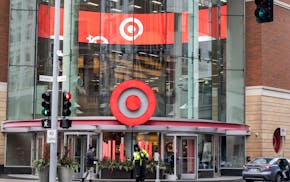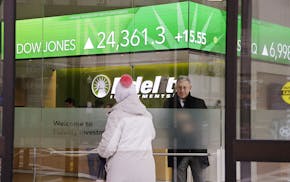For many, the loss of one of downtown St. Paul's key skyway arteries is an inconvenience.
But for Tommy Sar, who lives in an adjacent apartment and uses a wheelchair, it's untenable.
Earlier this month, the city closed routes surrounding three condemned buildings: the Alliance Bank Center, the St. Paul Athletic Club and the Capital City Plaza ramp. Owners of all three properties stopped paying for utilities, security and maintenance, causing city inspectors to deem them unfit for human habitation.
Weeks later, the temporary walls and locked doors are still catching commuters and visitors by surprise, forcing U-turns on lunchtime strolls or extended walks to the office. Sar, on the other hand, is well aware of the closures limiting his access to a large swath of downtown, including many of the businesses he used to regularly frequent.
When Sar moved downtown in 2019 to be close to his former job at the Ordway Center for the Performing Arts, the skyways were "one of the biggest amenities," he said.
Now his once-quick trip to the pharmacy is a much longer and more complicated errand. He no longer makes weekly visits to Legacy Chocolate, since the street-level route is too hilly. He's had to start looking at condos and apartments to move into after his lease is up in July.
"There are some downsides to living here," Sar said of downtown. "And there's less and less upsides."
Closing time
In the wake of the COVID-19 pandemic, downtowns across the country have struggled as office employees embraced remote and hybrid work. Parts of St. Paul's urban core are facing added challenges as Madison Equities, once downtown's largest property owner, is attempting to offload several financially distressed buildings such as the Alliance Bank Center and Capital City Plaza ramp.
Though city leaders acknowledge the current skyway disruption, they are quick to pronounce an optimistic outlook on the situation, saying bargain building prices will give prospective owners the ability to invest in ambitious redevelopments.
Some say this moment could also be ripe for reimagining the city's skyways. Joe Spencer, president of the nonprofit St. Paul Downtown Alliance, said he was happy to see many skyway-level businesses — forced out of the Alliance Bank Center — reopening in the nearby Town Square Building.
"I'm really interested to see what the experience is like when we essentially consolidate businesses and pedestrian traffic onto one spine of the skyway," Spencer said. "I think it's possible that spine will feel, frankly, a lot better."
The Twin Cities' downtown skyways have long been a controversial facet of urban life. Many residents, workers and visitors consider them a beloved amenity, particularly during winter months. Others argue skyways — in any downtown — vie with the streetscape for foot traffic and retail space, ultimately diminishing vibrancy on both levels.
Spencer noted the Alliance's downtown investment strategy, published last year to guide and inspire public and private initiatives, recommended "selective pruning" of skyways to improve the experience throughout the entire system.
"I'm not interested in having a debate over whether they're all good or all bad," Spencer said. "I think we can do it in a nuanced way where we're not debating all or nothing."
City Council President Rebecca Noecker, who represents the area, said she thinks the skyways will always be "a critical part of downtown."
"My vision would be that we have streams of people walking through the skyways at all hours of the day and also streams of people walking along the street at all hours of the day," she said. "From my perspective, the goal here is to get all of these buildings into new ownership — to either repurpose them, renovate them, bring them back to life — and then reopen the skyways."
Open plans
Such hopes might be on the horizon for the St. Paul Athletic Club, a historic building that most recently housed a fitness club, office space, banquet halls and a 56-room boutique hotel.
Minneapolis-based Youthprise has the property under contract and is seeking $4.5 million from the state to improve the energy efficiency of the building. Among many goals, the nonprofit hopes to use the building to provide housing for post-secondary students, offer recreational space for families and expand workforce training in hospitality and construction trades, Youthprise president Marcus Pope said in an email.
"We see this as a project that not only supports youth but also contributes meaningfully to downtown St. Paul's overall vitality," Pope wrote.
The futures of other properties, like the Alliance Bank Center, are more uncertain. An attorney for Madison Equities did not respond to a request for comment. Grant Beardsley, general counsel for lender Royal Credit Union, said in a statement the bank is "actively exploring all legal options."
A portion of the building's lobby remains open to allow access to a parking ramp under different ownership. Even during Wednesday rush hour, few passed through the cold and quiet building, where abandoned storefronts housed remnants of hasty moves. A discarded Chipotle bowl and spilled liquid sat near the top of out-of-service escalators.
City fire and police officers have been patrolling the condemned buildings, and inspectors are helping to bring them in line with minimal safety requirements, including those involving fire-suppression systems.
"I don't anticipate that [the Alliance Bank Center] will be in this state for an extended period of time, but it's still privately held," said Angie Wiese, director of St. Paul's Department of Safety and Inspections. "I would love to see a responsible owner sooner than later. It's a very large property, and it really is in kind of a central node in the skyway system."
Bob Wolf is glad to have left the building, despite its prime location. He reopened his business, Greenwolf Hemp and Organics, in a corner storefront in Town Square, where his new landlords charge "unbelievably fair" rent and offered to paint the walls forest green, his color of choice.
"It's been a little slow, but we're happy where we're at," Wolf said. "I think we just have to keep doing what we're doing, start with one or two buildings, fill them up with good people. Do some events and things. Get people to come back downtown again once they realize it's getting safer."
Sar hopes to see more downtown activities and businesses geared toward residents. He's been working remotely for a state agency the past few years and thinks Gov. Tim Walz's decision to call back employees for half the week starting this summer will not have the revitalizing effect on downtown that officials claim it will.
"There's way too much kowtowing to landlords and businesses that don't really have enough stake in the local neighborhood," Sar said. "Unless we change our mindset, there's no hope."

Ramstad: Minnesota's big businesses are in crisis with a common problem

'Brady Bunch'-style split-level homes enjoying a revival in Minnesota — with a twist

Now is the time to invest in bonds, with yields too good to ignore

Don't consider just your conflicts of interest. Be wary of your advisors', too

